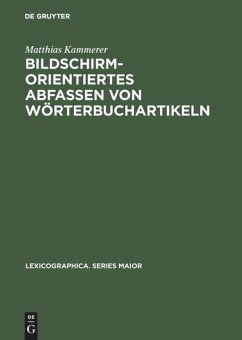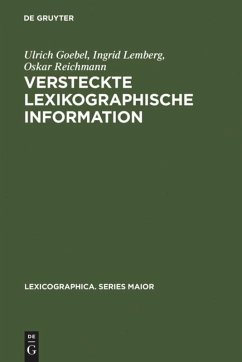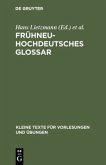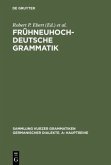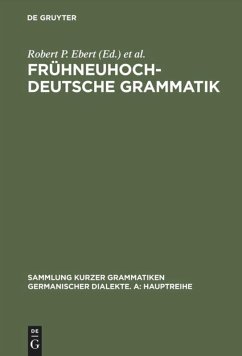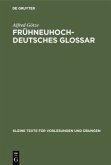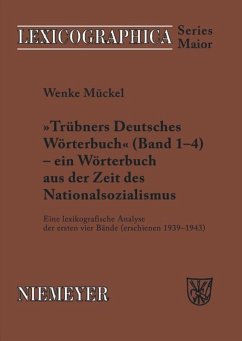Lexicographica. Series Maior features monographs and edited volumes on the topics of lexicography and meta-lexicography. Works from the broader domain of lexicology are also included, provided they strengthen the theoretical, methodological and empirical basis of lexicography and meta-lexicography. The almost 150 books published in the series since its founding in 1984 clearly reflect the main themes and developments of the field.
The publications focus on aspects of lexicography such as micro- and macrostructure, typology, history of the discipline, and application-oriented lexicographical documentation.
In dieser Arbeit geht es darum zu zeigen, wie der Computer bei der praktischen Wörterbucharbeit eingesetzt werden kann. Als Gegenstand der Exemplifizierung wurde das "Frühneuhochdeutsche Wörterbuch" gewählt, da es aufgrund seiner komplexen Struktur nicht wenige Probleme aufwirft. Nachdem kurz in die Theorie der Mikro- und Makrostruktur nach Wiegand eingeführt wurde, wird das Konzept der Positionsstruktur vorgestellt, das für diese Arbeit grundlegend ist. Im Anschluß daran wird die erste Lieferung des "Frühneuhochdeutschen Wörterbuchs" bezüglich des Artikelaufbaus exhaustiv analysiert. Die Ergebnisse werden in einer Konstituentenstrukturgrammatik zusammengefaßt. Danach werden die Beziehungen zwischen Lemmazeichentyp und Wörterbuchartikeltyp näher beleuchtet mit dem Resultat, daß ersteres zusammen mit dem Wörterbuchprogramm letzteres determiniert. Nachdem diese Interdependenzen geklärt sind, wird eine Eingabeoberfläche unter dem Textretrievalsystem FAUST definiert, mit der selbst die komplexeren Artikel des "Frühneuhochdeutschen Wörterbuchs" erfaßt werden können. An zwei Beispielen wird abschließend gezeigt, wie die Dateneingabe durch die Lexikographen aussehen könnte. Dabei zeigt sich, daß sich selbst Konsistenzprobleme (wie Verweise auf andere Wörterbuchartikel, insbesondere jene, die noch nicht geschrieben sind) in den Griff bekommen lassen.
Hinweis: Dieser Artikel kann nur an eine deutsche Lieferadresse ausgeliefert werden.
The publications focus on aspects of lexicography such as micro- and macrostructure, typology, history of the discipline, and application-oriented lexicographical documentation.
In dieser Arbeit geht es darum zu zeigen, wie der Computer bei der praktischen Wörterbucharbeit eingesetzt werden kann. Als Gegenstand der Exemplifizierung wurde das "Frühneuhochdeutsche Wörterbuch" gewählt, da es aufgrund seiner komplexen Struktur nicht wenige Probleme aufwirft. Nachdem kurz in die Theorie der Mikro- und Makrostruktur nach Wiegand eingeführt wurde, wird das Konzept der Positionsstruktur vorgestellt, das für diese Arbeit grundlegend ist. Im Anschluß daran wird die erste Lieferung des "Frühneuhochdeutschen Wörterbuchs" bezüglich des Artikelaufbaus exhaustiv analysiert. Die Ergebnisse werden in einer Konstituentenstrukturgrammatik zusammengefaßt. Danach werden die Beziehungen zwischen Lemmazeichentyp und Wörterbuchartikeltyp näher beleuchtet mit dem Resultat, daß ersteres zusammen mit dem Wörterbuchprogramm letzteres determiniert. Nachdem diese Interdependenzen geklärt sind, wird eine Eingabeoberfläche unter dem Textretrievalsystem FAUST definiert, mit der selbst die komplexeren Artikel des "Frühneuhochdeutschen Wörterbuchs" erfaßt werden können. An zwei Beispielen wird abschließend gezeigt, wie die Dateneingabe durch die Lexikographen aussehen könnte. Dabei zeigt sich, daß sich selbst Konsistenzprobleme (wie Verweise auf andere Wörterbuchartikel, insbesondere jene, die noch nicht geschrieben sind) in den Griff bekommen lassen.
Hinweis: Dieser Artikel kann nur an eine deutsche Lieferadresse ausgeliefert werden.
